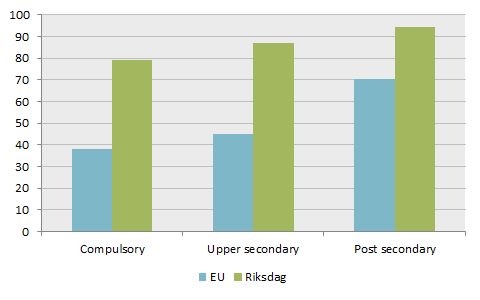General elections, Electoral participation survey:
Big differences in turnout by level of education
Statistical news from Statistics Sweden 2015-05-29 9.30
The voter turnout increased in the 2014 elections, but it did not increase in all parts of the country and there are still big differences between different population groups. For instance, the share is much bigger among those with higher level of education, particularly in the EU elections.
The 2014 elections to the European Parliament, the Riksdag (Swedish Parliament), County Councils and Municipal Councils were all held in the same year for the first time. In the election to the Riksdag, the voter turnout increased by 1.2 percentage points to 85.8 percent. This was the third election in a row with an increased turnout. Corresponding increases in the elections to County Councils and Municipal Councils were in total 1.4 and 1.3 percentage points respectively. In the Swedish election to the European Parliament the turnout improved by 5.5 points to 51.1 percent. It was the first time more that than half of those entitled to vote participated in a Swedish election to the European Parliament.
Statistics Sweden has been assigned by the Swedish government to analyse the voter turnout in the 2014 elections. These analyses reveal substantial differences in turnout between different parts of the country. In the election to the Riksdag 2014, the participation rate was more than 22 percentage points higher in Lomma than in Haparanda municipality. At the electoral district level the differences are even bigger. There were 5 837 electoral districts in total in the 2014 elections.
In the election to the European Parliament, 92 districts had a turnout of less than 30 percent. At the same time the turnout was over 80 percent in one district. In the election to the Riksdag, there were 3 districts where less than half voted, but at the same time there were 592 districts with a turnout over 90 percent. In both the EU election and the election to the Riksdag, the participation rates were low in those districts that had a high share of foreign born persons among those entitled to vote.
High turnout among the well-educated
In the 2014 elections, there were clear differences in voting rates between different groups. In the 2014 election to the Riksdag, 94 percent among those with post-secondary education voted, while 87 percent among those with upper secondary education and 79 percent among those with compulsory school education voted (the figures refer to the age group 18-74 years). In the EU election, the turnout was almost twice as high among those with post-secondary education as among those with compulsory school education, 71 compared to 38 percent. Among those with upper secondary education the turnout was 45 percent. In EU elections, the differences by education level have increased as the general turnout has improved.

Source: Statistics Sweden
Big differences among first-time voters
Among first-time voters, 83 percent voted in the 2014 Riksdag election. Granted, this is 5 percentage points lower than among the other eligible voters, but the difference was more than twice as large in the 2002 election. Compared with 2010, voter participation increased among first-time voters in 2014 by 2 percentage points. At the same time, we find considerable differences when looking at the tendency for first-time voters to vote. Voter participation is significantly higher among first-time voters who have taken a study preparation programme in upper secondary school than among those who have taken a vocational programme. In the 2014 Riksdag election, the turnout in the former group was 91 percent and 83 percent in the latter. In the EU election, the corresponding difference was 20 percentage points (60 compared to 40 percent) Clear differences also appear, depending on the parents' levels of education and if they have Swedish or foreign backgrounds.
More equal participation but not in EU elections
In the last three elections the turnout in elections to the Riksdag has increased. This increase has been more substantial within those groups who have a lower turnout. Hence, this has led to a more equal voter turnout. Still, it is worth noting that some differences regarding voting rates between different groups are greater now than they were in the beginning of the 1990s. For instance, this is the case regarding turnout by income and in particular by educational attainment.
The general pattern is that decreases in turnout lead to increased differences between population groups, and increases in turnout lead to decreased differences. However, the Swedish EU elections deviate from that pattern. The sharp rise in voter turnout that has occurred in the two last elections has not meant that the differences in voter turnout between different groups have dropped in the same way. Concerning voter turnout by level of education, the differences have instead increased.
About the survey
In September 2014, the Swedish government assigned Statistics Sweden (Ju2014/5631/D) to conduct a study with the purpose of analysing the voter turnout in the 2014 elections. The report Who chose to choose? Voter turnout in the 2014 elections constitutes Statistics Sweden’s report of that study.
Publication
Next publishing will be
The Party Preference Survey (PSU) will be published on June 3, 2015 at 09:30.
Feel free to use the facts from this statistical news but remember to state Source: Statistics Sweden.
